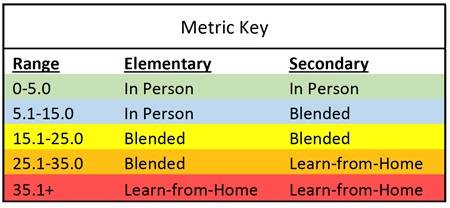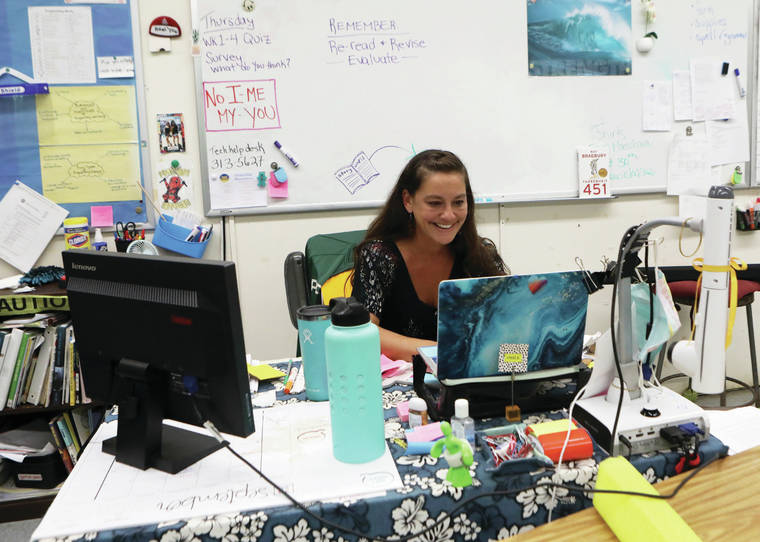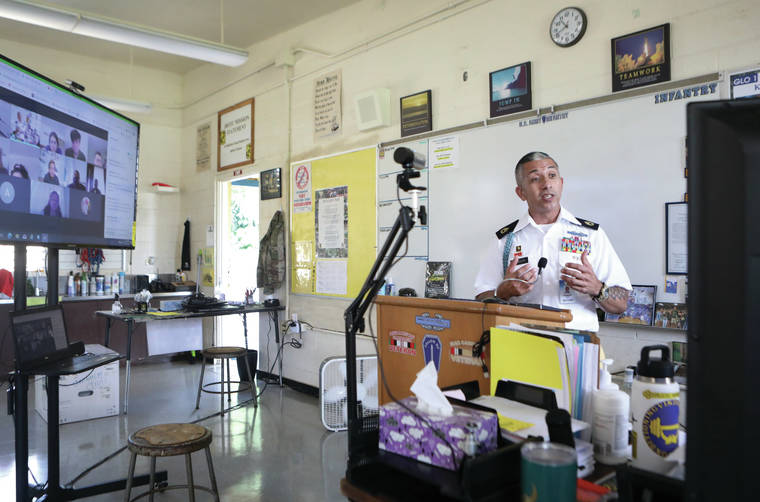There is still no set reopening date for classrooms in Hawaii, but the state health and education departments on Thursday provided metrics for how they plan to handle instruction based on the COVID-19 infection rate on each island.
During a Thursday morning media conference, Gov. David Ige said it is “so important as a next step in our reopening plans to be able to address children attending school.”
The “reopening thresholds” used to trigger each of three different learning models — distance learning, blended learning or in-person instruction — will be different for elementary and secondary students and will be determined by the number of infected people per 10,000 population on the island on which the school based.
Using those metrics, the Big Island — with a population of 201,513 and 216 COVID-19 cases between Sept. 1-14, has an infection rate of 10.7 people per 10,000 — could begin in-person instruction in elementary schools and blended learning for secondary schools.
“Our guidance is based on mitigation strategies promoted by the Centers for Disease Control and Prevention’s approaches to school reopening that have been implemented in other states,” said Dr. Sarah Kemble, the deputy state epidemiologist who spearheaded the development of a 28-page document outlining the plan, on Thursday.
“We recognize one size does not fit all, so instead of blanket statewide guidance, we developed a regional approach because disease transmission rates can differ on each island. This empowers school leaders to be responsive in the context of what is happening in their community.”
Department of Education Superintendent Christina Kishimoto said the DOE wants to transition to a blended-learning model during the second quarter of the school year, which starts Oct. 12.
Schools, which are in their fifth week of instruction, currently are in a distance-learning mode. Some students are in the schools, however, because of lack of access to high-speed internet or the equipment needed for distance learning, as well as some special education students.
Kishimoto said the metrics provided by the Department of Health “are a welcome tool that will help our schools plan for a safe and strategic return to a blended-learning model, based on sound data from our health experts.”
“The variation we’re seeing in case counts within individual communities means that we cannot adopt a statewide approach for all schools at one time,” Kishimoto said. “The new metrics provide benchmarks for our schools to use key health data to begin planning for a safe and strategic increase of on-campus access for students.”
Kishimoto said the DOE will attempt to start full in-person instruction during the second semester, which starts Jan. 4, 2021.
Kemble said the “goal is to prioritize reopening schools as safely as possible.”
“We know the benefits of in-person learning, and we need to provide decision-making tools on how and when schools can transition to different learning models, so that education of our youth can continue when circumstances change,” Kemble said. “… We believe these guidances will provide the tools, strategies and safe practices necessary for a balanced, practical and science-based decision making by school complexes.”
Kemble said when in-person instruction begins, “there will, inevitably, be positive cases, even when a school carefully coordinates plans.”
“All schools must be prepared for this and ready to work with the DOH, their staff, students and families to control the spread of illness,” she said.
Kemble said there is a special team of contact tracers assigned to DOE cases, but they are all on Oahu. She said COVID-19 cases in neighbor island schools will be handled by contact tracers in the DOH’s district offices.
“By necessity, those teams are more general, and will be handling both school cases and other types of cases, as well,” she explained. “However, they received the same training and protocols regarding school follow-ups.
“We do find on the neighbor islands, having a local point of contact is the most effective way to quickly exchange the information that’s needed.”
Corey Rosenlee, president of Hawaii State Teachers Association, said the teachers’ union was not consulted by the DOE or DOH in the formulation of the reopening plan.
“This is dangerous,” Rosenlee said during a separate media conference. “… When I heard the acting epidemiologist say, you know, we expect an increase in cases in our schools, those are not just numbers. Those are our keiki. Those are our teachers. Just this week, we had a staff member pass away due to the coronavirus.”
Rosenlee was referring to Dayna Inouye, a 49-year-old clerk at Sanford B. Dole Middle School in Honolulu’s Kalihi neighborhood, who, according to family, died Sept. 9 after contracting COVID-19 from an infected co-worker.
Rosenlee said that since the end of June, “we’ve already had 89 cases in our schools … and that’s with very few students on campuses.”
According to Rosenlee, no large school systems nationwide have had a successful opening. He added he’s received reports of very little personal protective equipment for teachers, and cleaning of common areas in schools has been inadequate.
Rosenlee said he’s asking the state Board of Education to step in “to make sure we go for distance learning until at least the beginning of the second semester.”
“If we were to try to bring 180,000 students back to campus … there’s going to be just a tremendous amount of cases that are going to put everyone in jeopardy,” he said. “… Our keiki and our teachers are not guinea pigs.”
The Board of Education had an online meeting Thursday afternoon, with dozens of teachers testifying against reopening, most citing safety reasons, inadequate sanitation and lack of PPE. One woman twice cried “say her name” while referring to Dayna Inouye.
One said students already in school learning hubs aren’t social distancing, and teachers are unable to enforce it.
A handful of parents urged board members to reopen schools, with one testifying that teachers are essential workers, and that students’ needs are not being met by distance learning.
The school reopening plan can be found online at https://health.hawaii.gov/coronavirusdisease2019/files/2020/09/COVID-19-Guidance-for-Schools-UPDATE-with-Appendix-091620.pdf.
Email John Burnett at jburnett@hawaiitribune-herald.com.











